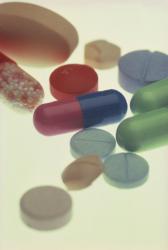Antihistamines are drugs that block the action of histamine. Histamine, also known as histamine phosphate, an amine (beta-imidazolyl- ethylamine, ergamine, or ergotidime) that is a normal constituent of almost all animal body cells. Histamine is also found in small quantities in ergot and purified meat products and is produced synthetically for medicinal purposes. In the body, it is synthesized in a type of leukocyte called a basophil or mast cell. In response to certain stimuli these cells release histamine, which immediately effects a dilation of the blood vessels. This dilation is accompanied by a lowering of blood pressure and an increased permeability of the vessel walls, so that fluids escape into the surrounding tissues. This reaction may result in a general depletion of vascular fluids, causing a condition known as histamine poisoning or histamine shock. Allergic reactions in which histamine is released, resulting in the swelling of body tissue, show similarities to histamine poisoning; the two may be basically similar, and the two conditions are treated similarly. The release of histamine might also be partly responsible for difficult breathing during an asthma attack. “In the 1930s the Italian pharmacologist Daniel Bovet who live in 1907-1972, working at the Pasteur Institute in Paris”, discovered that certain chemicals counteracted the effects of histamine in guinea pigs. The first antihistamines were too toxic for use on humans, but “by 1942 they had been modified for use in the treatment of allergies”. More than 25 antihistamine drugs are now available.
ethylamine, ergamine, or ergotidime) that is a normal constituent of almost all animal body cells. Histamine is also found in small quantities in ergot and purified meat products and is produced synthetically for medicinal purposes. In the body, it is synthesized in a type of leukocyte called a basophil or mast cell. In response to certain stimuli these cells release histamine, which immediately effects a dilation of the blood vessels. This dilation is accompanied by a lowering of blood pressure and an increased permeability of the vessel walls, so that fluids escape into the surrounding tissues. This reaction may result in a general depletion of vascular fluids, causing a condition known as histamine poisoning or histamine shock. Allergic reactions in which histamine is released, resulting in the swelling of body tissue, show similarities to histamine poisoning; the two may be basically similar, and the two conditions are treated similarly. The release of histamine might also be partly responsible for difficult breathing during an asthma attack. “In the 1930s the Italian pharmacologist Daniel Bovet who live in 1907-1972, working at the Pasteur Institute in Paris”, discovered that certain chemicals counteracted the effects of histamine in guinea pigs. The first antihistamines were too toxic for use on humans, but “by 1942 they had been modified for use in the treatment of allergies”. More than 25 antihistamine drugs are now available.
Histamine also causes contraction of involuntary muscles, especially of the genital tract and gastrointestinal canal, with an accompanying secretion by associated glands. Because histamine stimulates the flow of gastric juices, it is used diagnostically in patients with gastric disturbances. One drug effective in treating gastric ulcers acts by antagonizing the action of histamine. The ability of the body to localize infections may be due to the secretion of histamine and the subsequent increased local blood supply and increased permeability of the blood vessels. Antihistamines are used primarily to control symptoms of allergic conditions such as hay fever. They alleviate runny nose and sneezing and to a lesser extent, minimize conjunctivitis and breathing difficulties. Antihistamines can also alleviate itching and rash caused by food allergy. Chemically, antihistamines comprise several classes and a person who does not obtain relief from one type may benefit from another. Side effects of these drugs can include drowsiness, loss of concentration, and dizziness. People taking antihistamines should not drink alcoholic beverages or perform tasks requiring mental alertness, such as driving. A few antihistamines, such as terfenadine and astemizole, are nonsedating. Although antihistamines are included in many over-the-counter cold remedies, their usefulness in such preparations is questionable.
Antihistamines may relieve symptoms of allergy accompanying a cold, or they may have an anticholinergic effect that dries cold secretions, but they do not have any influence on viral infections, which are the cause of colds. Moreover, the drying effect may be undesirable, especially for persons with bronchial infection, glaucoma, or urinary tract difficulties. Although there are not many alternate drugs that have the same properties as antihistamines some non-drug treatments are also effective against allergies. The use of High-Efficiency-Particulate-Arresting (HEPA) filters, eliminate microscopic particles which cause allergies. The use of mattress covers decreases the reaction to dust mites in the mattress itself. These treatments are not equivalent to drug use but could decrease the amount of allergenic agents in the house hold air. Vitamin C also plays a role in the elimination of allergic reactions.”Researchers at the University of California have found that patients that suffer from atopic dermatitis benefited from large dosages of vitamin C”.
